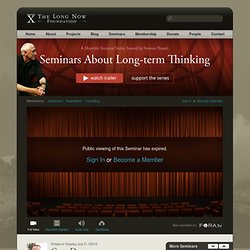

Chris Reid
I never had a chance to explain exactly what I mean.
New Tab. Who Can Name the Bigger Number? [This essay in Spanish][This essay in French]

Ross Andersen – Humanity's deep future. Sometimes, when you dig into the Earth, past its surface and into the crustal layers, omens appear.

In 1676, Oxford professor Robert Plot was putting the final touches on his masterwork, The Natural History of Oxfordshire, when he received a strange gift from a friend.
Daniel Estrada on Philosophy of Technology: Part 1 - hwcd. Recently I’ve met two compatriots, fellow philosophers of technology.

At some point we’ll get around to the second, but for now I’d like to introduce the first, Daniel Estrada. I met Estrada through mutual friends on Google+, and his informed commentary and fascination with ants and robotics and Turing quickly won me over. Daniel Estrada on Philosophy of Technology: Part 2 - hwcd. Continued from Part 1.

Responding to Daniel Estrada: Part 2.5 - hwcd. Design underdetermines use, causation underdetermines function.

I’d like to highlight a few thinkers that you may have heard of, but are not yet familiar with, to provide a brief comparison and contrast with your fascinating exposition on teleology and systems. There’s a lot out there, so this will be but a thumbnail sketch, but I hope it at least does not do a disservice to the thinkers in question. You mentioned “Object-Oriented Ontology” as perhaps a description for the multi-dimensional organizing relations that bind functions and users, and contrasted that with a “User-Oriented Ontology” that recognizes the system-level, in which a user/system imbues ateleological functions with their goal-orientations. That division isn’t as stark as it may seem, and I’m not sure whether you meant “Object-Oriented Ontology” to refer to the ontological system of Graham Harman et al, but there’s a much closer link than you may suspect.
Welcome to the Future Nauseous. Both science fiction and futurism seem to miss an important piece of how the future actually turns into the present. They fail to capture the way we don’t seem to notice when the future actually arrives. Sure, we can all see the small clues all around us: cellphones, laptops, Facebook, Prius cars on the street. Yet, somehow, the future always seems like something that is going to happen rather than something that is happening; future perfect rather than present-continuous. Even the nearest of near-term science fiction seems to evolve at some fixed receding-horizon distance from the present.
There is an unexplained cognitive dissonance between changing-reality-as-experienced and change as imagined, and I don’t mean specifics of failed and successful predictions. My new explanation is this: we live in a continuous state of manufactured normalcy. Realtechnik, Nausea and Technological Longing. The story of barbed wire is one of the most instructive ones in the history of technology.

The short version is this: barbed wire (developed between 1860 to 1873) helped close the American frontier, carved out the killing fields of World War I, and by spurring the development of the tank as a counter-weapon, created industrial-era land warfare. It also ended the age-old global conflict between pastoral nomads and settled agriculturalists (of animals, vegetables and minerals) and handed a decisive victory to the latter. Eternal Hypochondria of the Expanding Mind.
The story of neurasthenia or “invalidism” is a curious mid-nineteenth-century chapter in the story of the emancipation of women.

As Barbara Ehrenreich argues in Bright-Sided, it was almost entirely a social phenomenon: The largest demographic to suffer from neurasthenia or invalidism was middle-class women. Male prejudice barred them from higher education and the professions; industrialization was stripping away the productive tasks that had occupied women in the home, from sewing to soap-making. For many women, invalidism became a kind of alternative career. Designing for and Against the Manufactured Normalcy Field. This post tells the story of the session at FOO camp this year that I co-ran with Matt Webb on the Manufactured Normalcy Field.

It explains the background of the idea, describes the structure of the brainstorming session, outlines its results, and then tracks some of the uptake of the idea since FOO, specifically in a recent episode of A Show with Ze Frank. A few months back, Nick Pinkston turned me on to Ribbonfarm, the blog of Venkatesh Rao, a researcher and entrepreneur. Ever since, it’s become a reliable source of mind-grenades for me: explosive ideas that carve up reality in a way I’d never imagined and stimulate new ideas. Cory Doctorow: The Coming Century of War Against Your Computer. The war against computer freedom will just keep escalating, Doctorow contends.

The copyright wars, net neutrality, and SOPA (Stop Online Piracy Act) were early samples of what is to come. Victories in those battles were temporary. Conflict in the decades ahead will feature ever higher stakes, more convoluted issues, and far more powerful technology. The debate is about how civilization decides to conduct itself and in whose interests. Forget Peak Oil, We're At Peak Everything. Peak oil is the concept that new discoveries of commercially exploitable oil resources do not keep pace with growing demand.

By extrapolating the data, you can estimate when we will run out of it for all practical purposes. There are a lot of disagreements about whether we have reached peak oil or when the downhill slope will hit a point that brings a significant percentage of our vehicles to a grinding halt, but the concept has made scientists and policy makers ask the question: What other critical resources may be peaking? Asia Pulp & Paper Company, one of the world’s largest, announced last month that it will no longer use wood from natural forests for any of its $4 billion per year worth of products. Why? Because APP’s customers realized we are running out of natural forests from which to harvest lumber and have demanded suppliers to develop sustainable sources.
Another essential commodity that may soon hit its peak is food. The Banality of Cryonics (Philosophistry) I attended a cryonics conference over the weekend. The purpose of cryonics is to freeze people when they die until some unknown point in the future, when theoretically most life-threatening factors are eliminated (i.e. when cancer, old age, heart disease, etc. are cured). The conference was one of the most mind-blowing experiences of my life, and there's a lot of ways I could talk about it, but I'll limit myself to just one here for now.
I have a principle called the Banality of Futurism. Science fiction usually portrays a future chock full of mind-blowing or exotic experiences. However, our past experiences with technological enhancement seem to be a letdown. Cars. Church. Pants. Horses. The surprisingly deep history of trouser technology. Whence came pants? I'm wearing pants right now. There's a better than 50 percent chance that you, too, are wearing pants. And neither of us have probably asked ourselves a simple question: Why? It turns out the answer is inexplicably bound up with the Roman Empire, the unification of China, gender studies, and the rather uncomfortable positioning of man atop horse, at least according to University of Connecticut evolutionary biologist Peter Turchin. "Historically there is a very strong correlation between horse-riding and pants," Turchin wrote in a blog post this week.
How consciousness works – Michael Graziano. Scientific talks can get a little dry, so I try to mix it up. I take out my giant hairy orangutan puppet, do some ventriloquism and quickly become entangled in an argument. I’ll be explaining my theory about how the brain — a biological machine — generates consciousness. ? A Big Little Idea Called Legibility. James C. Scott’s fascinating and seminal book, Seeing Like a State: How Certain Schemes to Improve the Human Condition Have Failed, examines how, across dozens of domains, ranging from agriculture and forestry, to urban planning and census-taking, a very predictable failure pattern keeps recurring. The pictures below, from the book (used with permission from the author) graphically and literally illustrate the central concept in this failure pattern, an idea called “legibility.” States and large organizations exhibit this pattern of behavior most dramatically, but individuals frequently exhibit it in their private lives as well.
Along with books like Gareth Morgan’s Images of Organization, Lakoff and Johnson’s Metaphors we Live By, William Whyte’s The Organization Man and Keith Johnstone’s Impro, this book is one of the anchor texts for this blog. If I ever teach a course on ‘Ribbonfarmesque Thinking,’ all these books would be required reading. Paperwork Against the People. Paperwork Against the People Photo by redjar, 2000, Flickr creative commons The Demon of Writing: Powers and Failures of Paperwork by Ben Kafka Zone Books, 2012, 182 pp. Left 3.0. "Kludgeocracy: The American Way of Policy. Is JPMorgan a farmer? Imagine you’re a finance lobbyist and want to move deregulation and other industry-friendly policies through Congress. Sequencing The Genome Of Legal Documents To Make Them Readable. A few years ago, researchers at Cornell worked out that it would take 76 working days (25 days in all) to read all the privacy policies we agree to every year.
Book: Exit, Voice, and Loyalty. Summary[edit] Social Software Sundays #2 – The Evaporative Cooling Effect « Bumblebee Labs Blog. This is the second of a weekly series of posts on various aspects of social software design I find interesting, here is the full list. Tribes, Institutions, Markets, Networks. Book: The Origins of Political Order. The three components/pillars of a stable state according to Fukuyama The Origins of Political Order is a 2011 book by political economist Francis Fukuyama about what makes a state stable. It uses a comparative political history to develop a theory of the stability of a political system.
A Brief History of the Corporation: 1600 to 2100. The Rise of the Participatory Panopticon. Perspectives in Forecasting. Technology implies belligerence. Nov 20, 2012. Nassim Nicholas Taleb: The future will not be cool. How To See The Future. Shifting Frontiers and the Moon Landing. In Ian Morris's Big History, the Future Looms Large - The Chronicle Review.
Geographic History Enjoys a Renaissance. Collapse Is Humanity Adapting To Its Own Presence. Music in Human Evolution - Melting Asphalt. 15 Minutes of Meaning for Jonah Lehrer - Alexis C. Madrigal. Trying to See Through: A Unified Theory of Nerddom.